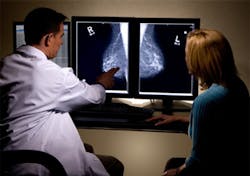Technique under development to improve cancer risk analysis
Researchers at the University of Sydney (Sydney, Australia) are aiming to develop a means to improve breast cancer detection.
Breast tissue density has been widely recognized as being strongly linked to the risk of developing breast cancer. Currently, the most common approach to determining a woman's breast density is for a radiologist to visually assess the percentage of fibroglandular tissue imaged on a mammogram, and assign it to a category of density from 1-4, which is known as the Breast Imaging Reporting and Data System (BI-RADS) classification system.
But University of Sydney's Dr Elaine Ryan said a more accurate and reliable measurement of breast density was urgently required because the measurement of breast density using mammogram imaging is inaccurate, subjective and unreliable.
Dr Ryan said that the researchers planned to determine whether measuring the structure and composition of breast tissue using x-ray fluorescence signals could be used to accurately measure breast density and predict risk of developing the condition.
"A more accurate measure - that does not depend on the subjective opinion of radiologists - would improve the reliability of breast density estimates for risk prediction and could lead to improved targeted screening programs for high risk women," she says.
The experimental approach will combine a measurement of the electron density, trace element content, liquid content and fat cell content into a model which could be correlated with mammographic breast density.
"An accurate measure of breast density will vastly improve current risk models, allowing better decisions to be made about an individual's screening program, and whether preventative measures may be appropriate to manage women's risk of developing this disease," she says.
-- by Dave Wilson, Senior Editor, Vision Systems Design
